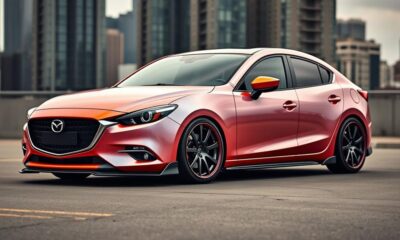Hyundai Tuning
Hyundai Elantra 2009 Tuning: Transforming Your Sedan Into a Performance Machine
Curious how to unleash the power of your 2009 Hyundai Elantra? Discover essential tuning tips that could transform your sedan into a performance powerhouse.

Tuning your 2009 Hyundai Elantra can turn your practical sedan into a dynamic performance machine. Start with essential upgrades like a cold air intake and a turbocharger to boost horsepower. Consider enhancing your exhaust system for improved sound and efficiency. Suspension modifications, such as coilovers and thicker sway bars, will enhance handling and stability. Don't forget stylish rims and high-performance tires for better grip. While evaluating costs and benefits, remember that some upgrades may greatly increase performance. If you're ready to release your Elantra's potential, there's plenty more to explore in the domain of modifications.
Key Takeaways
- Upgrade to a cold air intake to enhance airflow and increase horsepower for improved engine efficiency.
- Install a turbocharger for significant gains in engine output, transforming your Elantra's performance.
- Consider coilovers for adjustable ride height and improved handling, enhancing cornering and stability.
- Upgrade the exhaust system for a sportier sound and better engine efficiency, reducing back pressure.
- Research local emissions regulations to ensure all modifications are legal and compliant.
Overview of the 2009 Elantra
The 2009 Hyundai Elantra stands out as a practical compact sedan that balances performance and comfort. Powered by a 2.0-liter four-cylinder engine, it delivers 138 horsepower and 136 lb-ft of torque, making it suitable for daily driving. While it may not be a sports car, its front-engine, front-wheel-drive layout provides a solid foundation for those looking to explore performance upgrades.
You'll appreciate the comfortable interior, which offers ample space for both passengers and cargo, making it an excellent choice for commuting or family trips.
Standard safety features like front and side airbags, anti-lock brakes, and electronic stability control contribute to the Elantra's strong safety ratings, giving you peace of mind on the road.
If you're considering enhancing your driving experience, the Elantra's design allows for some aftermarket modifications. However, when contemplating performance upgrades, it's crucial to weigh the costs and benefits carefully.
While minor tweaks can improve your vehicle's responsiveness and handling, significant enhancements may require more extensive investment.
Essential Aftermarket Performance Parts

When you're looking to boost your 2009 Hyundai Elantra's performance, consider upgrading key components like the cold air intake and exhaust system.
These enhancements not only increase horsepower but also improve efficiency and sound.
Additionally, swapping out factory rims and tires can elevate both aesthetics and handling, giving you a more responsive driving experience.
Recommended Performance Enhancements
Upgrading your 2009 Hyundai Elantra can transform your driving experience and release its full potential. One of the best performance enhancements you can make is installing a cold air intake. This upgrade improves airflow to the engine, enhancing horsepower and throttle response.
If you're looking for a significant boost in power, consider adding a turbocharger; it can dramatically increase your Elantra's output.
For improved handling and cornering stability during spirited driving, enhancing your suspension with coilovers is a smart move. These allow for adjustable ride height and damping, giving you more control.
Additionally, swapping out your factory exhaust system can provide a sportier sound while reducing back pressure, leading to better engine efficiency and overall performance.
Aesthetic and Handling Upgrades
Transforming the look and handling of your 2009 Hyundai Elantra GLS can elevate your driving experience to new heights.
Start with upgraded rims and tires; they not only enhance aesthetics but also improve grip and cornering performance. With the right tires, you'll notice a significant difference in handling.
Next, consider upgrading the sway bar. Installing a thicker rear sway bar from the Touring model reduces body roll, leading to enhanced stability and a more engaging driving experience. You'll feel more connected to the road, especially during sharp turns.
Don't overlook the suspension components. Replacing factory end links with durable Moog end links can boost suspension responsiveness and longevity. This small change can dramatically improve overall vehicle handling, making your Elantra feel more agile.
While you may be tempted to add performance parts like a cold air intake or turbocharger, remember they often require a significant financial investment.
Always check local emissions regulations to verify your modifications are compliant. By focusing on aesthetic and handling upgrades, you'll transform your Elantra into a well-rounded performance machine that looks as good as it drives.
Evaluating Cost Vs. Benefit

When considering upgrades for your 2009 Elantra, you need to weigh the financial investment against the actual performance gains.
Many modifications can be costly, and without significant enhancements, they mightn't be worth it in the long run.
It's essential to evaluate whether the potential improvements justify the expenses and align with your vehicle's overall value.
Financial Investment Considerations
While investing in performance upgrades for your 2009 Hyundai Elantra can be tempting, it's important to weigh the costs against the expected benefits. Significant financial investment considerations often come into play, especially with older models like the Elantra GLS.
Basic modifications, such as cold air intakes or exhaust upgrades, mightn't justify their expense unless they align with your specific performance goals. The overall cost of aftermarket parts can escalate quickly, leading to financial implications that you should evaluate carefully.
Investing heavily in modifications could exceed the vehicle's value, making it wise to reflect on whether upgrading to a higher horsepower vehicle might yield better performance results.
Moreover, keep in mind that local emissions regulations can affect your upgrade choices. Certain modifications may not be compliant, which could result in additional costs for corrections or potential fines.
It's important to factor in these elements as you plan your upgrades. Ultimately, ensuring that your upgrades provide real value and align with your long-term goals will help you make the best financial decisions for your Elantra's performance tuning journey.
Performance Gains Assessment
Evaluating performance gains for your 2009 Hyundai Elantra involves careful consideration of both costs and benefits. While performance upgrades can enhance your driving experience, they often require substantial financial investment. Basic modifications like a cold air intake or exhaust system may yield minimal performance improvements, which might not justify the expense when compared to simply upgrading to a higher horsepower vehicle.
Here's a quick performance gains assessment to help you weigh your options:
| Modification | Estimated Cost | Potential Performance Gain |
|---|---|---|
| Cold Air Intake | $300 – $500 | Minor |
| Exhaust System | $400 – $800 | Minor |
| Coilovers | $1,062.50 | Moderate |
| Big Brake Kit | $3,000+ | Significant |
Keep in mind that many aftermarket parts deliver limited performance benefits, often necessitating extensive modifications or high-quality components. Additionally, local emissions regulations can impact your choices, as some upgrades may not be street-legal. Therefore, always consider the overall value of any performance gains against the costs involved.
Long-term Value Evaluation
Contemplating the long-term value of tuning your 2009 Hyundai Elantra requires a clear understanding of the costs versus the potential benefits. Significant financial investment is often necessary for meaningful performance upgrades, and these long-term costs can exceed the vehicle's overall value.
While basic modifications, like cold air intakes, might seem appealing, they often yield minimal improvements without additional investments in other areas. If you're aiming for higher horsepower, it might make more sense to weigh the option of upgrading to a different vehicle altogether rather than pouring money into modifications that may not deliver the performance gains you expect.
Additionally, be sure to check local emissions regulations before proceeding, as they can impact the feasibility and legality of certain upgrades. The cumulative cost of aftermarket parts can accumulate quickly, leading you to a situation where your total investment doesn't correlate with the expected performance enhancement.
As a result, careful evaluation is essential. Weighing the long-term costs against the benefits will help you make an informed decision, ensuring that any enhancements you pursue genuinely add value to your driving experience without breaking the bank.
DIY Upgrade Options

Upgrading your 2009 Hyundai Elantra can greatly enhance its performance and driving experience.
By focusing on DIY upgrades, you can boost power, improve fuel efficiency, and enjoy a more responsive ride. Here are three effective options to take into account:
- Upgrade Headlights: Replace your factory H11 bulbs with H9 bulbs. This simple swap increases brightness and visibility at night, enhancing safety and driving enjoyment.
- Enhance Handling: Swap out the factory end links with Moog end links. This upgrade boosts durability and considerably improves handling, giving you more confidence on the road.
- Sway Bar Installation: Install a thicker rear sway bar from the Touring model. This modification reduces body roll and enhances cornering stability, making your Elantra feel more planted during spirited drives.
Additionally, think about performing these upgrades as your factory parts begin to wear out.
This approach guarantees that your modifications are both effective and necessary, allowing you to maintain your vehicle's reliability while enjoying better performance and fuel efficiency.
With these DIY options, you'll turn your Elantra into a true performance machine.
Suspension Modifications and Benefits
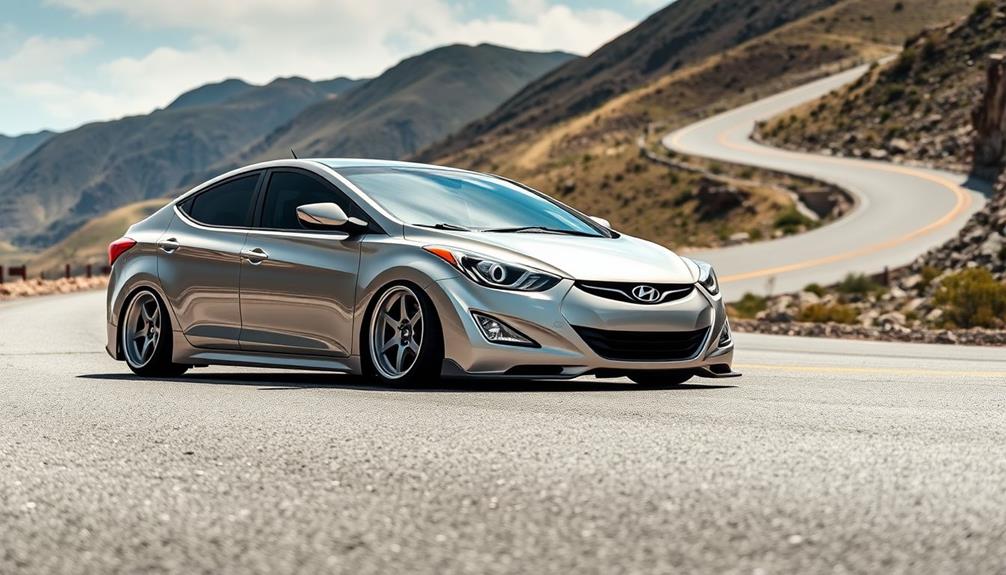
Suspension modifications can take your 2009 Hyundai Elantra's performance to the next level, building on the DIY upgrades you've already implemented.
Upgrading to coilovers greatly enhances cornering and control, offering a stiffer setup that reduces body roll and improves handling dynamics. This means you'll experience a more responsive ride, especially during sharp turns.
Consider installing a thicker rear sway bar from the Touring model. This simple modification helps correct the common understeer bias found in factory settings, resulting in a more balanced driving experience.
Performance suspension upgrades, like adjustable endlinks, are also important. They allow you to maintain ideal sway bar preload after lowering your vehicle, ensuring it performs at its best.
Don't forget to replace worn factory suspension components with high-quality alternatives. Degraded parts can negatively impact grip and your overall driving experience.
Finally, if you're looking for versatility, an air suspension system offers height adjustability. This lets you customize your ride height, improving both aesthetic appeal and performance for daily driving and light track use.
With these suspension modifications, your Elantra will feel transformed into a true performance machine.
Selecting the Right Coilovers
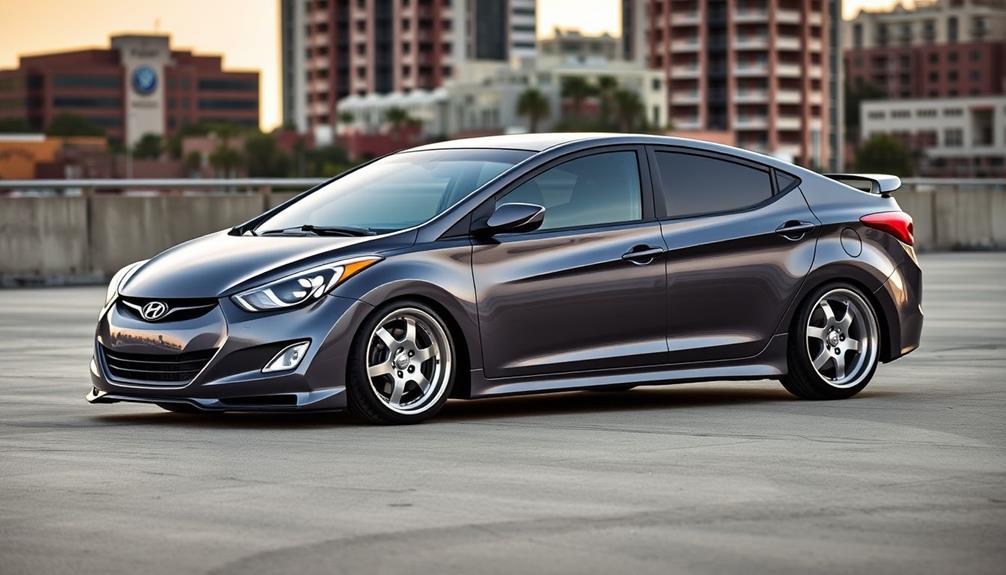
Choosing the right coilovers for your 2009 Hyundai Elantra can greatly enhance your driving experience. To guarantee you make the best choice, consider these key factors:
- Adjustability: Look for coilovers with adjustable ride height and damping, like the Kontrol Pro coilovers, which offer 36 levels of damping adjustment. This allows you to fine-tune your ride for both comfort and performance.
- Spring Rates: Pay attention to the spring rates of the coilovers. Stiffer springs can improve responsiveness but might sacrifice some ride comfort. It's crucial to find a balance that suits your driving style.
- Mounts: Opt for coilovers that come with pillowball top mounts instead of rubber mounts. Pillowball mounts enhance suspension precision and overall performance, giving you a more connected feel to the road.
Don't forget to choose monotube dampers over twin-tube designs for better heat dissipation and responsiveness.
Installing coilovers is usually a straightforward DIY project, making it an accessible upgrade for enthusiasts keen to enhance their Elantra's handling dynamics.
Community Resources and Insights

The 2009 Hyundai Elantra community is a treasure trove of resources and insights that can greatly aid your tuning journey. By diving into community forums, you'll find valuable perspectives from other Elantra owners who've walked the path of performance modification.
These discussions can guide your decisions on what upgrades to pursue, especially when it comes to low-cost options that enhance your ride without breaking the bank.
You'll also discover troubleshooting advice and product recommendations based on real-world experiences shared by fellow enthusiasts. Owners often post links to detailed upgrade guides, providing step-by-step processes for DIY modifications. This hands-on information helps you understand the effectiveness of specific aftermarket parts.
Engaging with community discussions not only broadens your knowledge but also highlights the cost versus benefit of various upgrades. This insight is essential when deciding which performance enhancements are worth your investment.
The community resources available are invaluable for making informed choices, ensuring your Elantra transforms into the performance machine you envision. Don't hesitate to tap into these insights; they can make a significant difference in your tuning journey.
Frequently Asked Questions
Can Hyundai Elantra Be Tuned?
Yes, you can tune your Hyundai Elantra. Upgrading performance chips, modifying the ECU, and enhancing airflow with aftermarket parts can greatly boost power and efficiency, making your driving experience more exciting and responsive. Additionally, suspension upgrades and new exhaust systems can improve handling and sound, making your vehicle feel more dynamic. When exploring Hyundai Elantra 2021 tuning options, it’s essential to ensure that any modifications are compatible with the car’s specifications and won’t void the warranty. With careful tuning, the Elantra can offer a perfect blend of performance and reliability tailored to your driving style.
What Are Common Problems With a 2009 Hyundai Elantra?
Roughly 15% of 2009 Hyundai Elantra owners report transmission issues. You might face problems with the front suspension, electrical components, or fuel pump, so staying on top of regular maintenance is essential for reliability.
Can You Tune a Hyundai?
Yes, you can tune a Hyundai! By installing performance chips or using tuning software, you're able to enhance engine performance, improve horsepower, and optimize fuel efficiency. It's an exciting way to boost your driving experience.
What Is Included in a Tune up for a Hyundai Elantra?
A tune-up for your Hyundai Elantra typically includes replacing spark plugs, changing the air filter, fuel filter replacement, checking ignition timing, and maintaining engine fluids. These steps enhance performance, fuel efficiency, and overall vehicle health.
Conclusion
In transforming your 2009 Elantra into a performance machine, you're not just upgrading a car; you're releasing a beast that can rival the most elite sports cars on the road! With the right aftermarket parts and a dash of DIY spirit, your sedan will zoom past the competition, leaving them in awe. So, gear up, plunge into the modifications, and watch as your Elantra evolves into a legendary driving experience that'll turn heads and drop jaws!
Alex is our go-to expert on performance tuning, with over a decade of experience in the automotive industry. His deep understanding of engine dynamics, exhaust systems, and performance software allows him to break down complex concepts into easy-to-follow guides. Whether you’re looking to boost horsepower or fine-tune your vehicle’s responsiveness, Alex’s insights will help you achieve peak performance.
Hyundai Tuning
Hyundai Sonata 2017 Tuning: Maximizing Power and Efficiency in Your Sedan
Maximize your 2017 Hyundai Sonata’s power and efficiency with expert tuning tips that could transform your driving experience—discover the secrets inside!

Tuning your 2017 Hyundai Sonata can greatly enhance both power and efficiency. Start with an ECU remap, which can boost horsepower by about 10-15. Adding a high-flow K&N air intake and performance exhaust system further improves airflow and torque. Consider upgrading to an electronic throttle controller to enhance throttle response. While basic modifications can cost between $500 and $700, they can yield impressive gains. Joining the Hyundai community can provide invaluable support and advice. Discovering more options for upgrades can take your driving experience to the next level and make all the difference in performance.
Key Takeaways
- Upgrade to a cold air intake system and K&N air filter to enhance airflow, boosting horsepower and torque by up to 10%.
- Consider ECU remapping and performance chip modules for increased horsepower up to 20 and improved fuel efficiency.
- Install a performance exhaust system to enhance sound and engine efficiency, adding around 10 horsepower and 7 lb-ft torque.
- Improve throttle response with electronic throttle controllers for a more engaging and responsive driving experience.
- Engage with the Hyundai community for tips, DIY projects, and support on tuning modifications to maximize your Sonata's performance.
Performance Gains Overview
When you tune the stock 2.4L GDI engine in the 2017 Hyundai Sonata, you can expect noticeable performance gains. From a BTR dyno test, you could see an increase of about 10 horsepower and 7 torque.
If you opt for an ECU tune, like the LAP3, you can release even more power while improving fuel efficiency and optimizing your engine's air-fuel ratios.
For those looking for significant enhancements, simple modifications such as exhaust headers and a K&N air intake system can elevate your Sonata to over 200 horsepower.
Additionally, porting and polishing the engine head might provide a potential boost of up to 30 horsepower, although you'll want to be cautious about costs.
Improving throttle response is also essential for performance. By utilizing electronic throttle controllers like the TROS Potent Booster, you can enhance your driving experience without necessarily increasing horsepower or torque.
Essential Modifications for Power
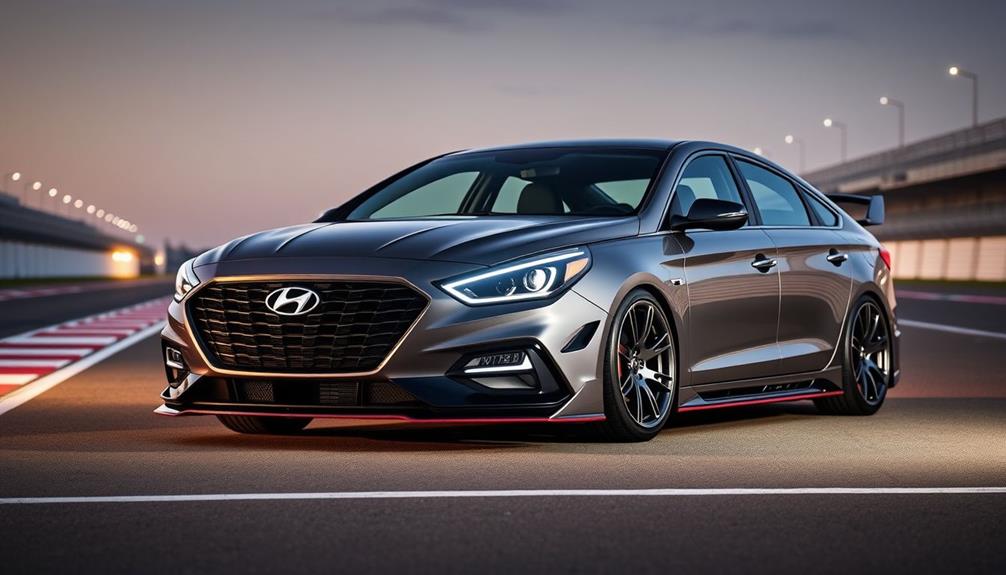
When it comes to boosting your 2017 Hyundai Sonata's power, certain modifications can make a significant difference.
You'll want to contemplate upgrades like a cold air intake, performance chip, and aftermarket exhaust to maximize performance gains.
We'll also weigh the costs against the benefits to help you make informed decisions on your tuning journey.
Performance Gains Overview
Tuning the 2017 Hyundai Sonata can transform your daily driver into a more spirited performer. By implementing a few essential modifications, you can achieve noticeable gains in engine performance. Upgrading the air intake and exhaust system can enhance airflow, resulting in improved horsepower and torque. Additionally, a performance ECU tune allows you to optimize engine parameters for better throttle response and fuel efficiency. For those exploring similar enhancements, many Hyundai Azera tuning tips can also be applied to the Sonata, given the shared engineering principles between the two models.
Start with a cold air intake system, which can optimize air intake and potentially boost horsepower and torque by up to 10%. Pair this with a high-performance K&N air filter to maximize airflow.
Next, consider upgrading to a performance exhaust system, like a 3-inch setup with resonator delete. This not only enhances the sound but also improves engine efficiency, contributing to overall performance gains. With these modifications, you might see an increase of around 10 horsepower and 7 lb-ft of torque.
For even greater throttle response, installing an electronic throttle controller, such as the TROS Potent Booster, can greatly improve your driving experience without directly impacting horsepower.
Finally, for those looking for a more advanced option, porting and polishing the engine head can yield an additional potential gain of around 30 horsepower, though this requires careful execution to avoid high costs.
Embrace these modifications, and you'll feel the difference every time you hit the road.
Recommended Upgrade Components
In order to maximize power and performance in your 2017 Hyundai Sonata, it's important to evaluate several key upgrades that can greatly enhance your driving experience.
By focusing on specific components, you can access the full potential of your sedan.
Here are three essential modifications to take into account:
1. Air Intake: Upgrading to a K&N air filter and cold air intake system can greatly improve airflow, boosting horsepower by up to 10% in your Sonata's 2.4L engine.
This enhancement not only increases power but also enhances engine efficiency.
2. Performance Chip: Installing a performance chip module can reveal hidden engine power, potentially increasing horsepower by up to 20 and torque by 25 lb-ft.
Additionally, you'll benefit from improved fuel economy, gaining up to 4 mpg.
3. Throttle Body: Think about upgrading to a larger throttle body.
This modification improves throttle response and overall acceleration, making your Sonata feel more responsive and enjoyable to drive.
Cost Vs. Benefits Analysis
Evaluating the costs versus the benefits of modifications for your 2017 Hyundai Sonata can help you make informed decisions about enhancing performance.
Basic upgrades, like a performance chip and cold air intake, can provide gains of up to 20 horsepower and 25 lb-ft of torque, all for a cost of around $500 to $700. This investment can greatly boost your engine's performance without the hefty price tag of a new vehicle.
Installing a K&N air filter and custom ECU reflash can optimize your air intake efficiency, enhancing throttle response and possibly improving fuel economy by up to 4 mpg.
Additionally, upgrading to a high-flow exhaust system, including headers and a 3-inch exhaust with resonator delete, can net you around 10 more horsepower and 7 lb-ft of torque.
While it's tempting to chase peak power, community insights suggest focusing on torque delivery across the RPM range for non-turbo models like the Sonata is often more beneficial.
Enhancing Throttle Response
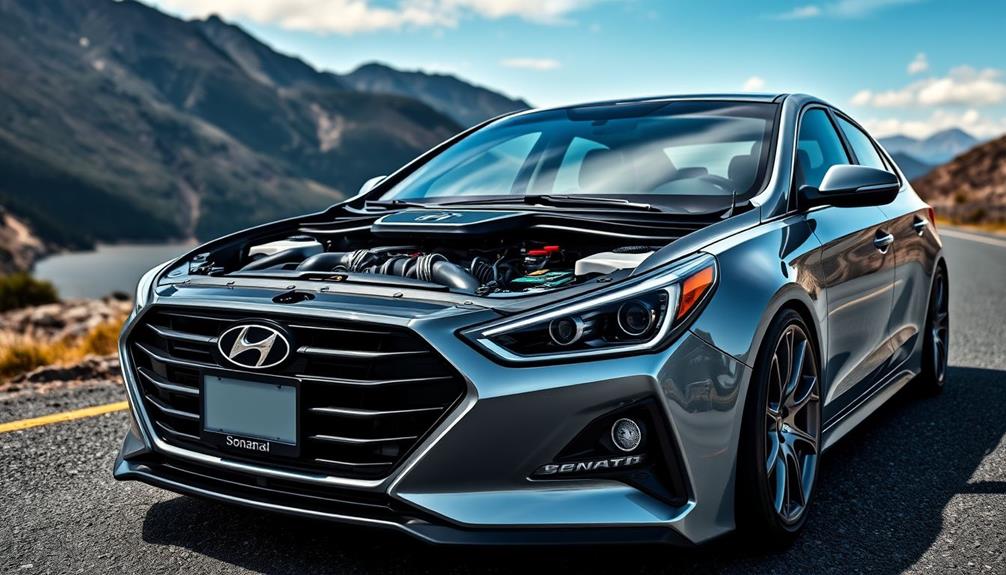
Improving throttle response can transform your driving experience, making it more engaging and responsive. When your Sonata's throttle response is enhanced, you'll notice a more immediate reaction when you press the gas pedal.
Here are some effective methods to achieve this:
- Install a TROS Potent Booster or Sprint Booster: These devices adjust the gas pedal voltage, increasing sensitivity without altering horsepower or torque directly.
- Consider a Pedal Commander: This electronic throttle controller improves responsiveness and eliminates lag, all without hardware modifications.
- Upgrade to a K&N air intake system: By optimizing airflow to the engine, you complement throttle response enhancements, leading to better overall performance.
Regular ECU tuning is also essential. By adjusting ignition timing and air-fuel ratios, you'll further refine throttle response, creating a more dynamic and engaging driving feel.
With these modifications, you can enjoy a sporty, responsive ride that brings excitement back to your daily drive. Making these upgrades not only boosts throttle response but also improves your Sonata's overall efficiency and performance.
Cost and Budget Considerations
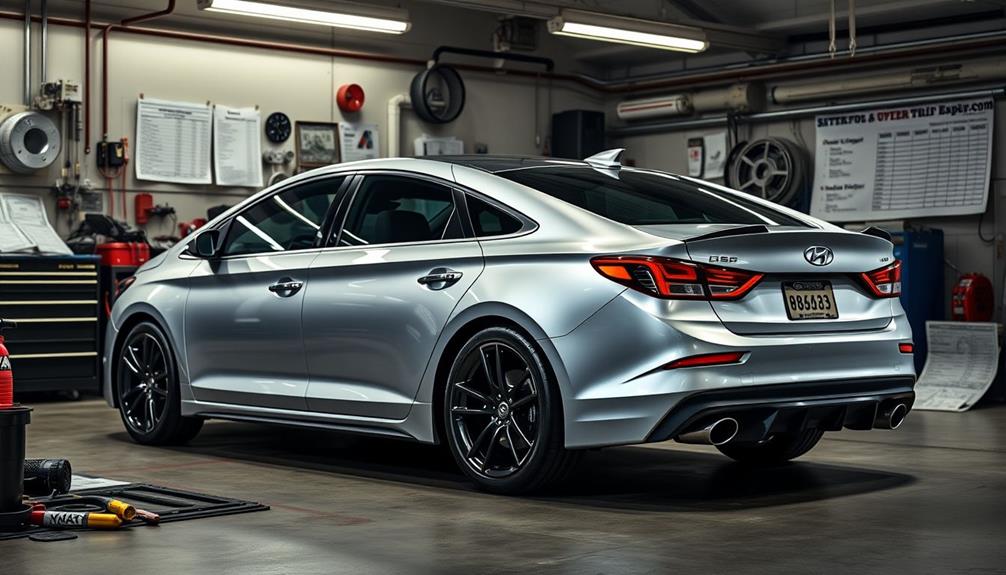
Upgrading your 2017 Hyundai Sonata can be an exciting journey, but it's important to keep your budget in check as you explore performance modifications.
Start by determining how much you're willing to invest. Basic modifications like chip tuning and supporting mods typically range from $500 to $700. If you're eyeing advanced options like cams and pulleys, you might add another $400 to $500 to your total.
For those craving considerable power gains, a T4 Turbo kit will set you back around $5,000, which can greatly impact your overall tuning budget. However, there's a silver lining—trading in your original parts can help offset these costs. Many dealerships offer better trade-in values, making it a smart financial strategy.
Consider more budget-friendly enhancements too. Upgrading to a K&N air filter or a 3-inch exhaust system can improve performance without breaking the bank, often costing between $200 and $500 each.
Community Support and Resources
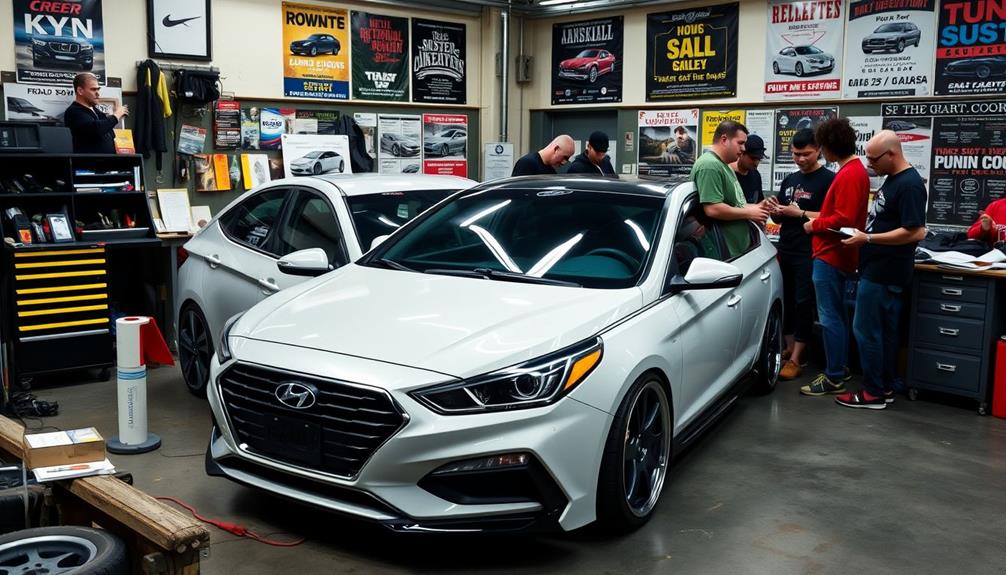
The tuning journey for your 2017 Hyundai Sonata can be greatly enhanced by tapping into community support and resources. Engaging with fellow enthusiasts not only broadens your knowledge but also offers practical insights on performance tuning and modifications.
Here are three key resources to evaluate:
- Hyundai Forum: This platform is essential for Sonata owners. You can exchange experiences, ask questions, and gain valuable advice on everything from air intakes to ECU tuning.
- Online Video Playlists: There are numerous guides available that provide step-by-step instructions for DIY tuning projects, including electric turbo installations. These resources make it easier for you to tackle modifications confidently.
- Local Support Groups: Connecting with local tuners can be incredibly helpful. They often provide hands-on assistance with machining and electronic upgrades, creating a collaborative learning environment.
Stages of Engine Tuning
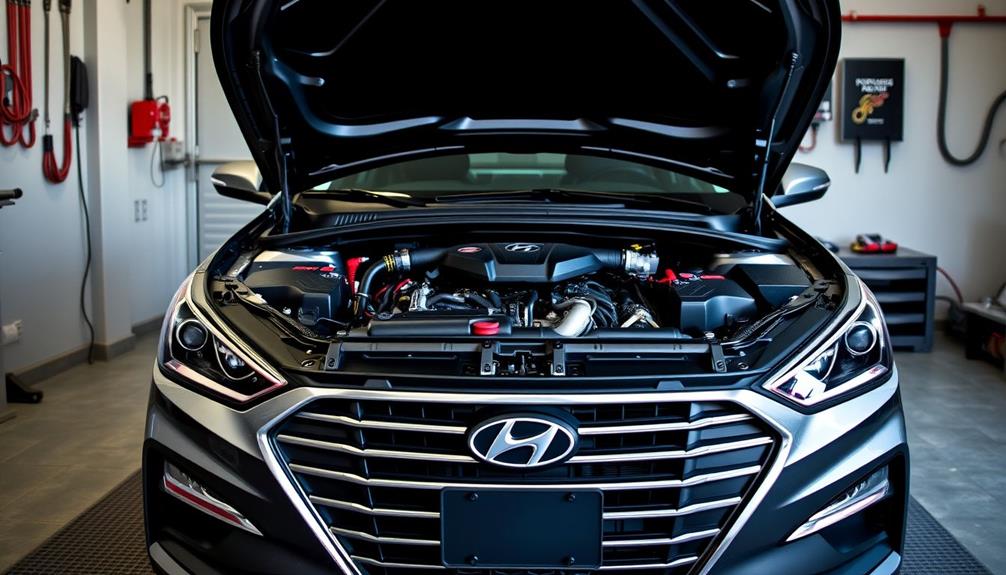
When it comes to tuning your 2017 Hyundai Sonata, understanding the different stages of engine modifications is essential for achieving your performance goals.
Stage 1 tuning usually starts with remapping the ECU, installing a sports exhaust, and upgrading to lightweight alloy wheels. These changes can boost your power levels by about 10-15 horsepower and improve throttle response.
Moving on to Stage 2 tuning, you'll focus on more advanced modifications like ported heads, fuel pump upgrades, and high-flow injectors. This can yield gains of 20-30 horsepower and enhance torque characteristics.
For those looking for serious performance, Stage 3 tuning introduces forced induction upgrades and internal engine modifications. This stage can see power increases of 30-50 horsepower but requires significant investment and expertise.
Frequently Asked Questions
How Often Should You Get a Tune up on a Hyundai Sonata?
You should get a tune-up for your Hyundai Sonata every 30,000 to 60,000 miles. Regular check-ups help maintain performance, fuel efficiency, and can prevent costly repairs, ensuring your vehicle runs smoothly over time.
Can You Modify a Sonata?
Absolutely, you can transform your Sonata into a powerhouse! By modifying components like the ECU, cold air intake, and exhaust system, you'll boost performance and enjoy an exhilarating driving experience you won't forget.
What Is the Fuel Efficiency for a Hyundai Sonata?
The fuel efficiency for a Hyundai Sonata varies by engine type. The 2.4L achieves 26 mpg city and 36 mpg highway, while the 2.0L turbo offers 23 mpg city and 32 mpg highway.
What Is the Most Powerful Hyundai Sonata?
The most powerful Hyundai Sonata is the 2017 Sonata Sport 2.0T, boasting 245 horsepower and 260 lb-ft of torque. It's equipped with a turbocharged engine that enhances both performance and efficiency for an engaging driving experience.
Conclusion
To sum up, tuning your 2017 Hyundai Sonata can greatly boost both power and efficiency. With the right modifications and a clear budget, you'll not only enhance your driving experience but also enjoy the journey. Remember, "a journey of a thousand miles begins with a single step." So, whether it's upgrading your exhaust or improving throttle response, take that first step and watch your sedan transform into a more dynamic ride. Happy tuning!
Alex is our go-to expert on performance tuning, with over a decade of experience in the automotive industry. His deep understanding of engine dynamics, exhaust systems, and performance software allows him to break down complex concepts into easy-to-follow guides. Whether you’re looking to boost horsepower or fine-tune your vehicle’s responsiveness, Alex’s insights will help you achieve peak performance.
Hyundai Tuning
Hyundai Azera Tuning: Enhancing Power and Luxury in Your Sedan
You can transform your Hyundai Azera into a powerhouse of performance and luxury; discover the essential upgrades that can elevate your driving experience.

Tuning your Hyundai Azera can elevate both its power and luxury, making for an exhilarating driving experience. By adding a cold air intake and a freer-flowing exhaust, you can boost horsepower by 15-30 HP. ECU tuning further enhances torque and throttle response. Don't forget about suspension upgrades like coilovers and performance tires, which improve handling and stability. Balancing comfort and performance is key. Make sure you consider your budget, as effective modifications start around $1,500. The journey to a superior Azera is exciting, and there's much more to explore about how to achieve peak performance and comfort.
Key Takeaways
- Performance modifications like cold air intakes and ECU tuning can boost the Hyundai Azera's horsepower by 15-30 HP and torque by 40 lb-ft.
- Upgrading suspension with coilovers and high-performance tires enhances handling, stability, and overall driving experience.
- Proper tuning and regular maintenance are crucial to avoid engine damage and ensure reliability after modifications.
- Safety is paramount; high-speed driving requires upgraded tires and careful consideration of vehicle stability.
- Engaging with the Hyundai Azera community provides valuable insights and support for tuning and maintenance.
Performance Modifications Overview
When it comes to tuning your Hyundai Azera, performance modifications can take your driving experience to the next level. By focusing on performance upgrades, you can considerably boost horsepower and torque, enhancing both acceleration and overall enjoyment.
Consider installing a cold air intake and a freer-flowing exhaust system to improve engine airflow. This not only elevates throttle response but can also enhance fuel efficiency, allowing you to enjoy spirited driving without sacrificing economy.
Upgrading your stock transmission is vital, as the original may limit the gains from your modifications. Additionally, adding coilovers and high-performance tires will improve handling and stability, making your Azera safer during spirited driving.
You can realistically expect performance gains of 15-30 horsepower from these upgrades, creating a more engaging driving experience.
Engine Specifications and Tuning

When tuning your 2013 Hyundai Azera, understanding the engine's specifications is essential for maximizing performance.
You'll want to take into account enhancements like turbocharging and ECU tuning, but keep in mind the necessary modifications and potential risks involved.
Regular maintenance and high-quality fuel play significant roles in ensuring your upgraded engine runs smoothly and reliably.
Engine Performance Enhancements
To maximize the performance of your 2013 Hyundai Azera, consider several engine enhancements that can greatly boost horsepower and torque. The stock 3.3L V6 engine has potential waiting to be revealed. One effective way to enhance performance is through ECU tuning, which can yield gains of 15-30 HP and up to 40 lb-ft of torque, considerably improving throttle response and overall driving dynamics.
Upgrading to a performance chip can also reveal hidden potential with easy plug-and-play installation. Additionally, improving your air intake allows more airflow into the engine, further increasing power output.
Here's a quick overview of the potential enhancements:
| Enhancement | Potential Gains | Benefits |
|---|---|---|
| ECU Tuning | 15-30 HP, 40 lb-ft | Enhanced throttle response |
| Performance Chip | Varies by model | Reveals engine potential |
| Air Intake Upgrade | 5-15 HP | Improved airflow |
| Exhaust System | 5-10 HP | Better fuel efficiency |
| Cold Air Intake | 10-20 HP | Increased engine efficiency |
These enhancements can lead to a more powerful and efficient driving experience.
Tuning Considerations and Risks
Before diving into tuning your 2013 Hyundai Azera, it's crucial to weigh the considerations and risks associated with modifying engine specifications.
While tuning can offer significant performance upgrades, not all modifications guarantee safety or reliability. Here are three key factors to keep in mind:
- Engine Integrity: Your Azera's 3.3 V6 engine has a high compression ratio of 11.5:1, which complicates turbocharging. Without proper tuning, you risk detonation, leading to costly engine damage.
- ECU Tuning: Enhancing the ECU can yield an extra 15-30 horsepower and boost torque by up to 40 lb-ft. However, this must be done carefully. Inadequate tuning can jeopardize your engine's longevity and performance.
- Fuel Mixture Management: Achieving effective performance gains requires a solid understanding of fuel grade, temperature, and cylinder pressure.
An improper fuel mixture can result in poor performance and detonation issues.
Turbocharging Options and Considerations

Turbocharging the Hyundai Azera offers a compelling way to boost performance, but it comes with specific factors to take into account. Using a turbo from a Genesis Coupe is feasible, but you'll need to verify compatibility with your stock internals to maintain engine reliability. Here's a quick overview of the key aspects to keep in mind:
| Factor | Details |
|---|---|
| Compatibility | Verify turbo fits stock internals |
| Modifications | Tune, upgraded exhaust, free-flowing intake |
| Compression Ratio | High compression (11.5:1) requires careful tuning |
You'll also need to take into account relocating components like the battery due to space constraints. Proper tuning post-turbocharging is essential for enhancing your engine's longevity and performance. It's advisable to use low boost pressure to mitigate detonation risks.
Finding aftermarket support can be tricky since options for the Azera are limited compared to sportier models. Engaging with the community for insights can make a significant difference in your tuning experience. By keeping these aspects in mind, you can enjoy the benefits of turbocharging while minimizing potential issues.
ECU Tuning and Performance Chips

When you're considering ECU tuning and performance chips for your Hyundai Azera, you'll notice several benefits, like increased horsepower and torque.
However, it's crucial to weigh the risks associated with tuning against alternative power enhancements.
Let's explore how you can optimize your ride while keeping your vehicle safe and efficient.
Performance Chip Benefits
Performance chips offer a straightforward way to boost your Hyundai Azera's engine performance. By optimizing your vehicle's ECU settings, these chips can increase horsepower by 15-30 and torque by up to 40 lb-ft.
Plus, their installation is user-friendly, typically involving a simple plug-and-play setup that maintains your warranty.
Here are three key benefits of using performance chips:
- Improved Throttle Response: Experience quicker acceleration and better drivability, making every drive more enjoyable.
- Enhanced Fuel Economy: Many users report fuel savings of up to 4 mpg, thanks to optimized fuel-air mixtures that improve efficiency without sacrificing power.
- Customer Satisfaction: Most performance chips come with money-back guarantees, allowing you to try them without risking your engine's safety.
With these advantages, performance chips make it easier to elevate both the power and luxury of your Hyundai Azera.
Risks of ECU Tuning
ECU tuning can offer impressive power gains, but it's essential to recognize the risks involved. While you might enjoy horsepower increases of 15-30 HP and torque enhancements of up to 40 lb-ft, improper tuning can lead to engine damage or even failure.
Many users have reported reliability issues with performance chips, and these can void your manufacturer warranty, complicating future repairs.
One of the significant risks of ECU tuning lies in installation errors. Without professional expertise, you could accidentally cause severe engine issues, negating any potential power increase.
Furthermore, modifying your ECU can alter your vehicle's stability and handling, which might impact your insurance coverage in the event of an accident.
Don't forget about emission regulations either. Tuning your ECU may push your vehicle out of compliance with local environmental laws, leading to potential fines or legal issues.
Alternative Power Enhancements
For Hyundai Azera owners looking to boost their vehicle's performance, alternative power enhancements like ECU tuning and performance chips can be game changers.
These modifications not only elevate horsepower and torque but also enhance the driving experience.
Here's what you can expect from these enhancements:
- Increased Power: ECU tuning can add 15-30 horsepower and up to 40 lb-ft of torque, making your Azera feel more responsive.
- Improved Throttle Response: With performance chips like the Stage 3 OBDII module, you'll enjoy quicker acceleration and an overall more engaging drive.
- Fuel Savings: Upgrading can improve fuel efficiency, potentially saving you up to 4 miles per gallon, depending on your driving conditions.
Both ECU tuning and performance chips prioritize safety and engine health, ensuring that you can enhance performance without compromising reliability.
By opting for these alternative power enhancements, you not only release your Azera's hidden potential but also enjoy a more luxurious and thrilling driving experience.
Embrace these upgrades and feel the difference on every drive!
Suspension and Handling Upgrades

When it comes to enhancing the Hyundai Azera's suspension and handling, upgrading components like coilovers can make a noticeable difference.
Coilovers allow you to adjust ride height and improve suspension stiffness, which helps maintain stability at higher speeds. This upgrade can dramatically enhance your driving experience, especially during spirited driving.
Don't overlook the importance of upgraded tires. While OEM tires are rated for speeds up to 149 mph, performance tires offer better grip and responsiveness, which are vital for high-speed stability and safety.
Additionally, consider solid or urethane motor mounts to reduce engine movement. This improvement enhances power transfer to the wheels, boosting overall handling and performance during acceleration.
Incorporating suspension modifications like sway bars can also reduce body roll during cornering, giving you a more controlled and engaging driving experience.
It's essential to strike a balance between comfort and performance, so look for suspension upgrades that enhance handling without sacrificing ride quality.
Cost and Budget for Modifications

Tuning your Hyundai Azera can be an exciting venture, but it's essential to plan your budget wisely. Tuning your Hyundai Azera can be an exciting venture, but it’s essential to plan your budget wisely. Start by researching cost-effective upgrades that not only enhance performance but also ensure the reliability of your vehicle. While focusing on your Azera, it might also be helpful to explore Honda CRV 2016 tuning tips for inspiration, as many of the principles, such as optimizing airflow or upgrading suspension components, can apply across different models. Always prioritize quality over cheap parts to maximize your car’s potential safely.
You'll want to guarantee you can afford the modifications that will enhance performance without breaking the bank. Here's a quick breakdown of potential costs to evaluate:
- Basic Modifications: Starting with engine and suspension tweaks, expect to spend around $1,500. For significant enhancements, aim for a budget of approximately $3,000.
- Performance Upgrades: If you're eyeing options like porting, supercharging, or exhaust modifications, be prepared for additional expenses. These performance upgrades often involve complex changes that can quickly add to your budget.
- High-Quality Parts: Investing in quality aftermarket parts and professional installation can further increase your total cost. Remember, significant engineering changes, like a standalone engine management system, can substantially raise your expenditure.
To maintain a balance between performance and luxury, focus on modifications that enhance your driving experience without compromising comfort.
Safety and Speed Considerations
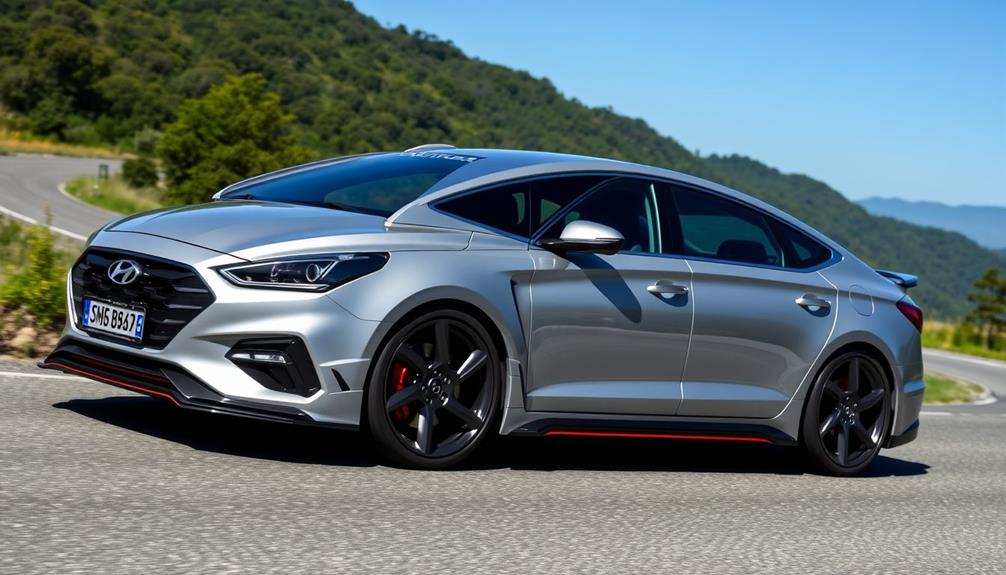
Modifying your Hyundai Azera for speed can be thrilling, but it's important to keep safety in mind. Achieving speeds over 90 mph is generally considered unsafe under most conditions, so moderation in your performance enhancements is significant.
While the manufacturer claims a top speed of 160 mph, verified testing shows a maximum of 153 mph on flat roads. High-speed driving naturally increases the risk of accidents, especially on uneven surfaces, making defensive driving techniques crucial.
When you pursue performance improvements like porting and supercharging, be aware that they can elevate the risk factor. The stock transmission might limit your speed capabilities, which often necessitates a custom transmission for significant gains.
Additionally, don't overlook the importance of upgraded tires rated for high speeds; OEM tires are only rated for up to 149 mph. This enhancement is important for maintaining stability and ensuring your safety at elevated speeds.
Ultimately, prioritizing safety while tuning your Azera for performance will allow you to enjoy the thrill of high-speed driving without compromising your well-being.
Always remember, speed is exhilarating, but safety should always come first.
Community Resources and Support

Finding support and resources within the Hyundai Azera community can markedly enhance your tuning journey.
With over 807.3K posts and 61.4K members, this vibrant forum community is packed with valuable insights from fellow owners and enthusiasts. Engaging with this community not only helps you gather knowledge but also fosters connections with like-minded individuals who share your passion.
Here are three key resources to leverage:
- Tuning Threads: Engage in discussions about tuning modifications and maintenance tips. You'll find a treasure trove of shared experiences that can guide your decisions.
- Safety Recommendations: Take note of advice emphasizing safety in high-speed driving. Many members advocate for dedicated track cars when pursuing performance goals, ensuring a responsible approach to tuning.
- Maintenance Insights: Regular maintenance is essential for the longevity of your Azera. Community members often share stories, like a 2007 Azera reaching 316,000 miles, which highlight the importance of caring for your vehicle.
Aftermarket Parts and Upgrades

Upgrading your Hyundai Azera with aftermarket parts can transform your driving experience, delivering enhanced performance and efficiency. One of the best investments you can make is a cold air intake. This modification considerably improves airflow to your engine, resulting in a noticeable boost in horsepower and torque.
Coupled with performance ECU tuning, you can gain an additional 15-30 horsepower and up to 40 lb-ft of torque, optimizing ignition timing and enhancing throttle response.
Installing a freer-flowing exhaust system and upgraded headers further enhances engine performance while reducing back pressure, leading to improved acceleration. Lightweight crank pulleys and high-performance spark plugs are also effective upgrades that enhance engine efficiency without compromising safety.
If you're looking to fine-tune your driving experience, consider adding a Pedal Commander device. This little gadget offers customizable driving modes that improve throttle response and fuel efficiency, all while being easy to install and maintaining your manufacturer's warranty.
With these aftermarket parts and upgrades, you'll not only boost the Azera's performance but also enjoy a more engaging and luxurious driving experience.
Frequently Asked Questions
Is the Hyundai Azera Fast?
The Hyundai Azera isn't the fastest sedan on the market. While it offers decent performance with a top speed around 153 mph, achieving extreme speeds requires significant modifications and could compromise safety and reliability.
Why Is Hyundai Azera Discontinued?
In 2016, full-size sedan sales dropped by 29%, pushing Hyundai to discontinue the Azera. You'll find automakers focusing on SUVs and crossovers, as consumer preferences shifted towards larger, more versatile vehicles.
What Car Is Comparable to a Hyundai Azera?
If you're considering alternatives to the Hyundai Azera, look into the Kia Cadenza, Toyota Avalon, Chevrolet Impala, Nissan Maxima, or Ford Taurus. Each offers luxury, space, and performance that might suit your needs perfectly.
How Many Miles Can You Put on a Hyundai Azera?
With proper care, your Hyundai Azera can achieve astonishingly high mileage, often exceeding 200,000 miles. Regular maintenance and premium fuel play pivotal roles in preserving performance and prolonging the life of your reliable ride.
Conclusion
In the domain of performance sedans, tuning your Hyundai Azera can transform it from a mere chariot into a sleek stallion, galloping ahead of the pack. With a keen eye on power and luxury, you can elevate your driving experience to new heights. So, embrace the art of modification and let your Azera shine like a diamond in the rough. Remember, every great journey begins with a single upgrade—make yours unforgettable.
Alex is our go-to expert on performance tuning, with over a decade of experience in the automotive industry. His deep understanding of engine dynamics, exhaust systems, and performance software allows him to break down complex concepts into easy-to-follow guides. Whether you’re looking to boost horsepower or fine-tune your vehicle’s responsiveness, Alex’s insights will help you achieve peak performance.
Hyundai Tuning
Hyundai Accent 2004 Tuning: Unlocking the Full Potential of Your Subcompact Car
Fuel your passion for performance as you explore how to transform your 2004 Hyundai Accent into an exhilarating driving machine. Discover the possibilities ahead!

Tuning your 2004 Hyundai Accent can radically enhance its performance, turning it into a fun-to-drive subcompact. Start with suspension upgrades like lowering springs or coilovers for improved handling. Consider an upgraded exhaust system and a cold air intake to boost power and efficiency. If you're ready for a bigger change, think about an engine swap or turbocharging for significant horsepower gains. Don't overlook performance chips and high-quality spark plugs to guarantee peak engine function. Each modification adds a unique benefit, paving the way for a more thrilling ride. Discover how to maximize your tuning journey and make your Accent stand out. In addition, lightweight aftermarket wheels and high-performance tires can further elevate your car’s agility and responsiveness. Interior enhancements such as upgraded seats and a racing steering wheel can also enhance your driving experience. Whether it’s a 2004 or you’re diving into Hyundai Accent 2003 tuning, the same principles apply—small, well-chosen mods can transform your daily driver into an exhilarating machine.
Key Takeaways
- Upgrade the suspension with lowering springs or coilovers for improved handling and cornering stability in your Accent.
- Install a cold air intake and performance exhaust system to enhance airflow and increase horsepower and torque.
- Consider an engine swap to the 2.0L Beta engine for significant power improvements over the stock 1.6L engine.
- Turbocharging the Accent can dramatically boost horsepower and torque, providing a responsive driving experience.
- Utilize performance chips and diagnostic tools to optimize engine performance and monitor modifications effectively.
Suspension Modifications
When it comes to enhancing the performance of your 2004 Hyundai Accent, suspension modifications are a game-changer. By upgrading your suspension, you can dramatically improve both handling and ride quality.
Start with lowering springs like B&G or Eibach, which drop your car by 1.7 inches and 1.2 inches, respectively. This gives your Accent a more aggressive stance and better cornering abilities.
If you want to take it a step further, consider installing coilovers. They allow you to lower your vehicle beyond 2 inches, plus you can adjust both ride height and dampening to suit your driving style.
Replacing stock struts with KYB GR2 gas struts also enhances handling performance, providing improved stability during turns.
To boost chassis rigidity, install front and rear strut bars. These modifications are straightforward and cost-effective, contributing notably to cornering stability.
Finally, adding a rear sway bar, such as the Ultra Racing option, can further stabilize your vehicle during turns.
With these suspension modifications, you'll reveal the full potential of your Hyundai Accent, transforming it into a sportier and more responsive ride.
Exhaust System Upgrades

Upgrading the exhaust system on your 2004 Hyundai Accent can considerably enhance both engine performance and sound. One effective option is to install a catback exhaust system, like the Evofusion model, which not only improves sound but also provides slight performance boosts. If you're looking for more power, consider adding headers; however, be aware that this might lead to a louder exhaust note and could trigger the check engine light if not paired with a catalytic converter.
Here's a quick comparison of popular exhaust upgrades:
| Upgrade Type | Benefits | Considerations |
|---|---|---|
| Catback System | Better sound, slight performance | Minimal installation effort |
| Headers | Significant power increase | May cause check engine light |
| Catalytic Converter | Emission compliance | Removal causes issues |
| Exhaust Tips | Custom look | Minimal performance impact |
| Full System Upgrade | Maximum performance | Higher investment |
Combining these exhaust system upgrades with other performance modifications is essential for maximizing horsepower and torque. Remember, regular maintenance and assessment of your exhaust system are vital to ensuring peak performance and compliance with local emissions laws.
Intake System Improvements

A well-designed intake system can greatly boost your 2004 Hyundai Accent's performance. One of the best options is a Cold Air Intake (CAI), which allows cooler, denser air to enter the combustion chamber. This results in improved horsepower and torque, giving your engine a noticeable performance upgrade.
If you're looking for a more budget-friendly option, consider short ram intakes. While they can enhance throttle response, they may draw in warmer air, which could limit your overall gains.
To maximize airflow, installing a high-flow air filter alongside your new intake system is vital. This addition can lead to slight improvements in fuel economy and acceleration, making your car even more responsive.
Remember, proper installation of your intake system is important. It helps mitigate issues related to warm air intake, ensuring you get the best performance possible.
If you're serious about tuning your Accent, consider combining these intake upgrades with exhaust enhancements. This synergy can yield significant performance improvements, allowing your subcompact car to truly shine.
With a few strategic modifications, you can access the full potential of your Hyundai Accent and enjoy a more exhilarating driving experience.
Engine Swap Options

When considering engine swap options for your 2004 Hyundai Accent, the 2.0L Beta engine stands out as a popular choice, offering notable performance improvements with minimal modifications.
You might also explore turbocharging, which can greatly enhance your car's power without the need for a full engine replacement.
Understanding these options will help you make the best decision for your tuning goals.
2.0L Beta Swap
Contemplating an engine swap for your 2004 Hyundai Accent? The 2.0L Beta engine is a popular choice among enthusiasts looking to boost their car's performance. Swapping out the stock 1.6L Alpha engine for the Beta can deliver significant horsepower and torque gains, giving your Accent a much-needed performance upgrade.
When planning your Beta swap, it's important to evaluate engine mounts and transmission compatibility. Some modifications may be necessary to guarantee a proper fit, so be prepared for a bit of work.
Fortunately, many enthusiasts have completed successful Beta swaps, thanks to the extensive aftermarket support available for the Beta engine platform.
Keep in mind that updating the ECU and supporting components is vital for peak performance. This will help integrate the Beta engine with your vehicle's systems, making sure everything runs smoothly after the swap.
With the right approach, you can reveal the full potential of your 2004 Hyundai Accent, transforming it into a more powerful, exciting ride. So, if you're ready to take your tuning journey to the next level, a Beta swap could be the perfect solution.
Turbocharging Advantages
Turbocharging offers a transformative upgrade for your 2004 Hyundai Accent, greatly enhancing both horsepower and torque output. By adding a turbocharger, you can experience significant performance gains—often exceeding 100 horsepower—depending on your setup and tuning. This increase in power provides a more responsive driving experience, improving acceleration and overall performance in various driving conditions.
If you're considering turbocharging, you might also want to explore engine swap options. Swapping the stock 1.6L Alpha engine for a more robust 2.0L Beta engine can be an excellent choice. The Beta engine is better suited for forced induction systems and can handle the added stress of a turbocharger more effectively.
Moreover, properly installed turbo systems can also enhance fuel efficiency. By optimizing the fuel-air mixture and promoting better combustion, you'll not only gain power but could also improve your miles per gallon.
This means you can enjoy the thrill of turbocharging without sacrificing efficiency. Overall, turbocharging, coupled with an engine swap, can release your Accent's full potential, making it a formidable performer on the road.
Performance Chip Enhancements

Performance chip enhancements can considerably elevate your 2004 Hyundai Accent's engine capabilities. By installing a performance chip, you're not just making a small tweak; you're revealing the potential for significant gains in horsepower and torque.
For instance, the Stage 3 Performance Chip OBDII Module, priced at $239.95, boasts a multi-core CPU and can release up to 30% more power, transforming your Hyundai Accent Hatchback into a more robust performer.
If you're looking for a more budget-friendly option, the Stage 1 Performance Chip Module OBD2 is available for $99.99 and is specifically designed to enhance engine performance with advanced technology tailored for your vehicle.
Additionally, consider the Mega Raizin Voltage Performance Chip at $49.99, which improves engine stability by effectively regulating voltage.
Don't overlook the Raizin Voltage Stabilizer for $44.95, ensuring peak performance during your modifications.
Each of these performance chip modules comes with a money-back guarantee, assuring you of their safety and compatibility with your Hyundai.
With these enhancements, you're well on your way to experiencing a more powerful and responsive driving experience.
Air Intake Systems

Upgrading your 2004 Hyundai Accent with an air intake system can yield impressive improvements in horsepower and torque. By enhancing airflow, a cold air intake system can greatly boost your car's performance compared to a short ram intake, which pulls in warmer air that can hinder efficiency.
Performance air intake systems are designed not just for power, but also for better fuel efficiency and acceleration. If you're looking for a cost-effective option, short ram intake kits are priced around $89.99 and can deliver up to a 10% increase in horsepower and torque. This makes them an attractive option for budget-conscious drivers wanting a quick upgrade.
For peak performance, consider a cold air intake, typically made from T304 lightweight aluminum piping. Proper installation is essential to achieve noticeable gains in engine responsiveness.
Many aftermarket air intake systems are tailored specifically for the 2004 Accent, ensuring compatibility and ease of installation. By choosing the right system, you can release the full potential of your subcompact car and enjoy a more exhilarating driving experience.
Diagnostic Tools

To maximize the benefits of your upgraded air intake system, it's important to monitor your vehicle's performance and diagnose any potential issues effectively. One essential tool for this task is a Universal OBD2 Code Reader Scanner, which you can pick up for just $29.95. This device reads diagnostic codes for check engine lights, helping you identify problems quickly, so you can address them before they escalate.
If you want to enhance your diagnostic capabilities further, consider using an OBD2 Splitter Extension Cable for $18.95. This allows you to connect multiple devices simultaneously, making it easier to analyze your Hyundai Accent's performance.
Additionally, an OBD2 Extension Cable, priced at $14.49, lets you mount performance modules further from the OBDII port, giving you easier access for chip tuning.
These diagnostic tools are user-friendly and compatible with most vehicles, making them essential for regular maintenance and troubleshooting.
By utilizing these tools, you'll save time and effort during diagnostics, allowing for quicker identification and resolution of performance issues.
With the right tools in hand, you'll be well-equipped to reveal your Hyundai Accent's full potential.
Spark Plugs and Sensors

Ideal engine efficiency hinges on the vital role of spark plugs and sensors in your 2004 Hyundai Accent.
Upgrading to Iridium Performance Spark Plugs can greatly enhance your engine's performance. These plugs feature a 0.4mm electrode tip that generates a more concentrated spark while requiring 5,000 fewer volts than conventional options. At a price of $59.95, it's a worthy investment for improved throttle response and overall engine efficiency.
Oxygen sensors are another essential component, especially for models from 2001 to 2011.
Priced at $29.99, these sensors monitor oxygen levels in the exhaust, optimizing engine performance and ensuring fuel efficiency. Regularly replacing oxygen sensors not only helps prevent issues with fuel consumption but also keeps your vehicle compliant with environmental regulations.
Thermal Management Solutions

Maintaining ideal engine performance goes beyond just spark plugs and sensors; thermal management solutions are also key. One effective option is Header Exhaust Intake Thermal Heat Tape, priced at $26.95. This product considerably reduces under-hood heat, protecting engine components and enhancing both longevity and performance.
You can easily wrap this heat tape around headers or exhaust systems, preventing heat-related damage. It's suitable for all internal combustion engines, including turbocharged models. By lowering under-hood temperatures, this thermal management solution helps maintain peak operating conditions for your engine, which can improve efficiency and power output.
Here's a quick comparison of the benefits:
| Feature | Benefit | Impact on Performance |
|---|---|---|
| Heat Reduction | Protects engine components | Increases longevity |
| Easy Installation | DIY-friendly | Saves time and cost |
| High-Temperature Resistance | Durable construction | Long-lasting protection |
Investing in thermal management solutions like heat tape can reveal your Hyundai Accent's maximum performance, ensuring your engine runs cooler and more efficiently. Don't underestimate the importance of heat management in your tuning journey!
Frequently Asked Questions
Is Hyundai Accent a Subcompact Car?
Yes, the Hyundai Accent is a subcompact car. Its compact design, lightweight profile, and smaller engine options make it ideal for urban driving and fuel efficiency. You'll find it easy to maneuver in tight spaces.
Conclusion
By tuning your 2004 Hyundai Accent, you're not just enhancing performance; you're transforming your car into a responsive, agile companion that dances on the road. Picture the thrill of sharp turns and the roar of a finely-tuned engine, as you release a symphony of power beneath the hood. With every upgrade, your subcompact becomes a canvas for your creativity, reflecting your passion for driving. Embrace the journey and watch your Accent evolve into something truly extraordinary.
Alex is our go-to expert on performance tuning, with over a decade of experience in the automotive industry. His deep understanding of engine dynamics, exhaust systems, and performance software allows him to break down complex concepts into easy-to-follow guides. Whether you’re looking to boost horsepower or fine-tune your vehicle’s responsiveness, Alex’s insights will help you achieve peak performance.
-

 Tesla Tuning2 months ago
Tesla Tuning2 months agoTesla Cybertruck Sales: How Many Have Been Sold So Far?
-

 Tesla Tuning2 months ago
Tesla Tuning2 months agoTesla Battery Replacement Costs Revealed: How Much Will You Pay?
-

 Tesla Tuning2 months ago
Tesla Tuning2 months agoSupercharging Tesla: How Long Does It Really Take?
-

 Tesla Tuning2 months ago
Tesla Tuning2 months agoWhere Are Tesla Cars Made? Explore the Manufacturing Locations!
-
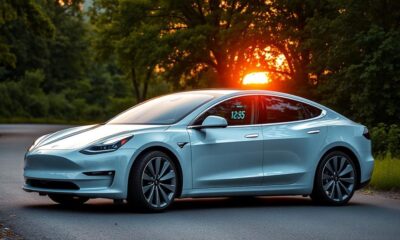
 Tesla Tuning3 months ago
Tesla Tuning3 months agoTesla Mileage: How Many Miles Can You Drive on a Full Charge?
-

 Tesla Tuning2 months ago
Tesla Tuning2 months agoHow Much Does It Cost to Lease a Tesla? Get the Full Breakdown!
-

 Tesla Tuning3 months ago
Tesla Tuning3 months agoTesla CarPlay: Does Tesla Have Apple Integration?
-

 BMW Tuning3 months ago
BMW Tuning3 months agoBMW B58 Tuning: Maximize Power in BMW’s Powerful Six-Cylinder Engine


















